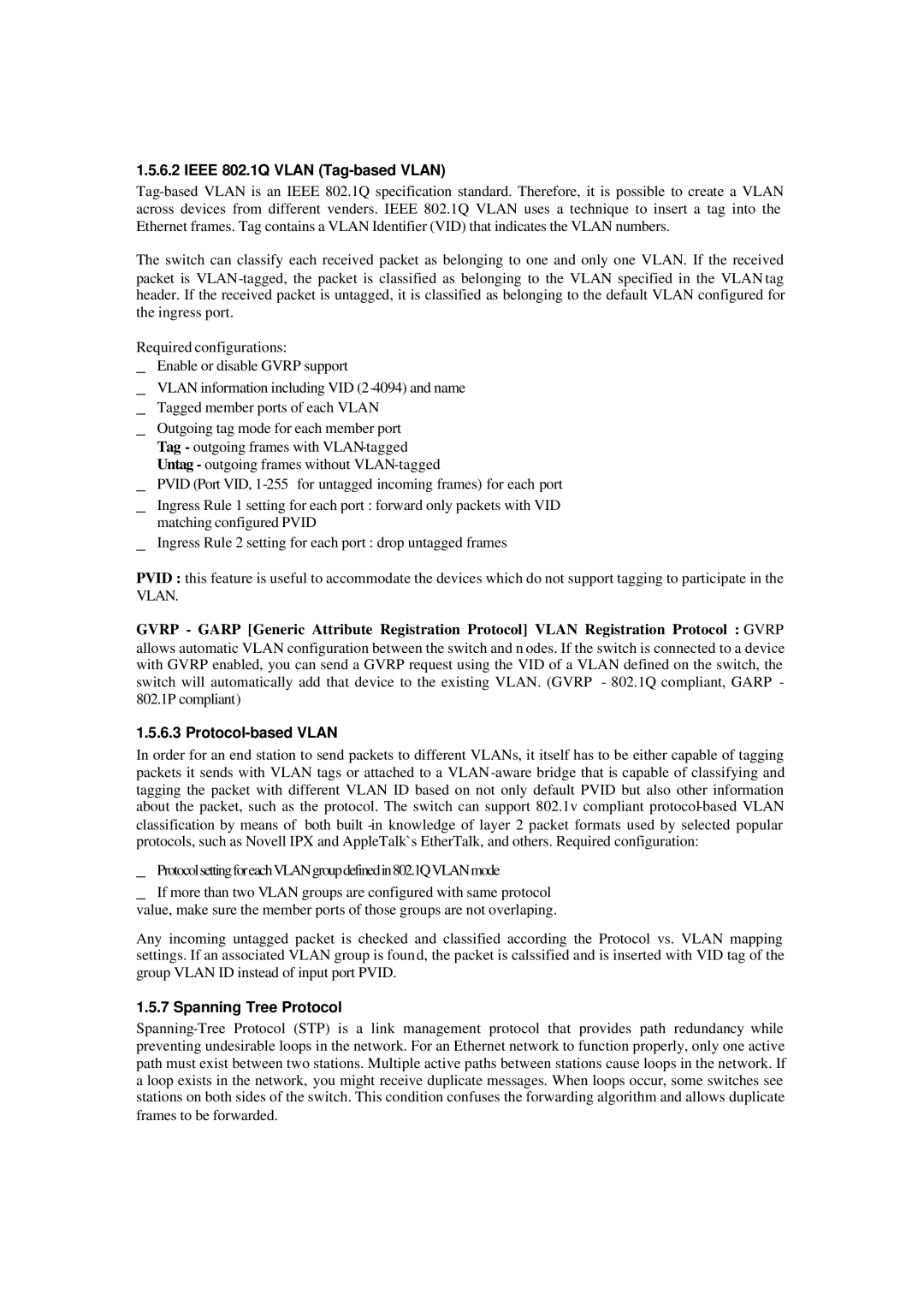_
_
_
_
_
_
_
1.5.6.2 IEEE 802.1Q VLAN (Tag-based VLAN)
Tag-based VLAN is an IEEE 802.1Q specification standard. Therefore, it is possible to create a VLAN across devices from different venders. IEEE 802.1Q VLAN uses a technique to insert a tag into the Ethernet frames. Tag contains a VLAN Identifier (VID) that indicates the VLAN numbers.
The switch can classify each received packet as belonging to one and only one VLAN. If the received packet is VLAN-tagged, the packet is classified as belonging to the VLAN specified in the VLAN tag header. If the received packet is untagged, it is classified as belonging to the default VLAN configured for the ingress port.
Required configurations:
Enable or disable GVRP support
VLAN information including VID (2-4094) and name
Tagged member ports of each VLAN
Outgoing tag mode for each member port Tag - outgoing frames with VLAN-tagged Untag - outgoing frames without VLAN-tagged
PVID (Port VID, 1-255 for untagged incoming frames) for each port Ingress Rule 1 setting for each port : forward only packets with VID matching configured PVID
Ingress Rule 2 setting for each port : drop untagged frames
PVID : this feature is useful to accommodate the devices which do not support tagging to participate in the VLAN.
GVRP - GARP [Generic Attribute Registration Protocol] VLAN Registration Protocol : GVRP allows automatic VLAN configuration between the switch and n odes. If the switch is connected to a device with GVRP enabled, you can send a GVRP request using the VID of a VLAN defined on the switch, the switch will automatically add that device to the existing VLAN. (GVRP - 802.1Q compliant, GARP - 802.1P compliant)
1.5.6.3 Protocol-based VLAN
In order for an end station to send packets to different VLANs, it itself has to be either capable of tagging packets it sends with VLAN tags or attached to a VLAN -aware bridge that is capable of classifying and tagging the packet with different VLAN ID based on not only default PVID but also other information about the packet, such as the protocol. The switch can support 802.1v compliant protocol-based VLAN classification by means of both built -in knowledge of layer 2 packet formats used by selected popular protocols, such as Novell IPX and AppleTalk`s EtherTalk, and others. Required configuration:
_ ProtocolsettingforeachVLANgroupdefinedin802.1QVLANmode
_ If more than two VLAN groups are configured with same protocol value, make sure the member ports of those groups are not overlaping.
Any incoming untagged packet is checked and classified according the Protocol vs. VLAN mapping settings. If an associated VLAN group is found, the packet is calssified and is inserted with VID tag of the group VLAN ID instead of input port PVID.
1.5.7 Spanning Tree Protocol
Spanning-Tree Protocol (STP) is a link management protocol that provides path redundancy while preventing undesirable loops in the network. For an Ethernet network to function properly, only one active path must exist between two stations. Multiple active paths between stations cause loops in the network. If a loop exists in the network, you might receive duplicate messages. When loops occur, some switches see stations on both sides of the switch. This condition confuses the forwarding algorithm and allows duplicate frames to be forwarded.
